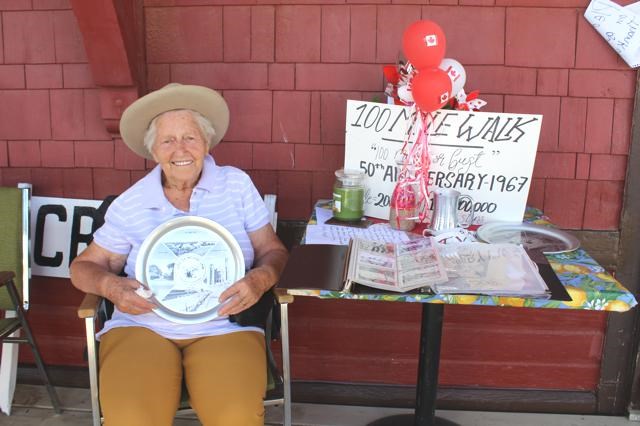Ninety-year old Nellie Schafer was accepting handshakes and well-wishes like a rock star on August 13. Sitting on the deck of the Rockglen Tourism Centre, she enjoyed the local Canada150 celebrations and accepted the well wishes. But 50 years ago, few thought that Schafer and her three friends, Margaret Karst, Mildred Wittman and Velma Shaw, would achieve their goal of walking 100 miles to Moose Jaw as a way to mark Canada’s Centennial.
The four set off from Rockglen in matching outfits on May 28, 1967 after a grand send off with a 21-gun salute, a speech from then-mayor Harold Ekdahl, horn-blowing and hand-waving. Schafer, Karst, Wittman and Shaw walked 25 miles a day. They arrived in Moose Jaw four days later to fan-fare, media interviews, a police escort and crowds lining the streets.
The four middle-aged friends decided on the walk after gathering at Schafer’s house one evening and discussing how they wanted to do something special to celebrate the Centennial. Their project had the full support of their spouses.
To prepare for the trek the women didn’t worry too much about exercising, they just wanted to get a week’s worth of chores done beforehand. Life was different a half a century ago and it involved a lot of walking.
“I walked a lot,” Schafer explained about her daily regime. She would walk to town for the mail, as well as several miles to check the cows a few times a day. Although she is 90, she says that she still walks as much as she can today. The women noted in their daily diary from 1967 that they were concerned about finishing jobs like planting the garden and preparing food for the trip and packing the converted bus in which they overnighted.
The four met with a lot of skepticism and they had a hard time getting sponsors, Schafer added. Their determination changed minds once they were on their way. “We had fun,” Schafer recollects.
They played practical jokes on their friends driving by in cars like hiding in the ditches as if one of them dropped out of the walk. They encountered tremendous generosity as they passed through the towns on Highway 2. Towns like Lisieux organized a meal for the walkers when they passed through, while cars often stopped along the way to offer food and beverages.
The women were something of a phenomenon by the time they reached Moose Jaw. They received extensive newspaper and radio coverage. They also had a police car lead them along the final stretch to the city centre. Along Moose Jaw streets shopkeepers came out of their stores and offered bottles of ginger ale, some people waved, and some gave them envelopes with a few dollars. Main Street was thick with crowds all the way to city hall. The Moose Jaw mayor presented them with the city’s souvenir plate. When they returned to Rockglen, there was also a welcome home party waiting.
Schafer, Karst, Wittman and Shaw marked Canada’s Centennial in style, but in their own small way, they changed perceptions about the capabilities and opportunities for women in 1960s southern Saskatchewan. Judging from the reception Schafer received at the Rockglen Canada150 celebrations, the community is still in awe about her achievement. “This was the best thing we ever did in our lives,” the friends wrote in their memoirs about their walk.




